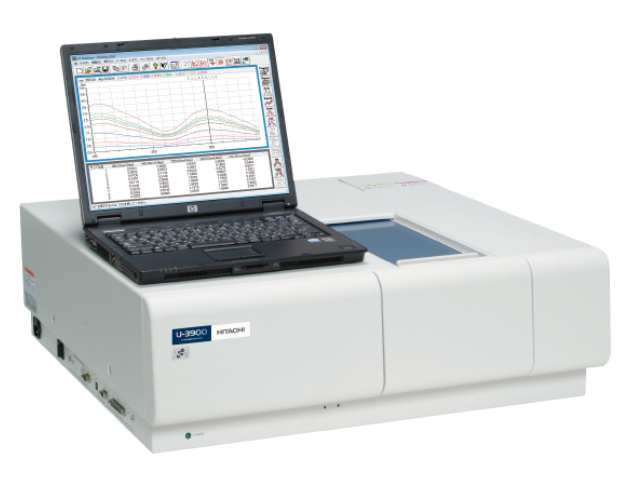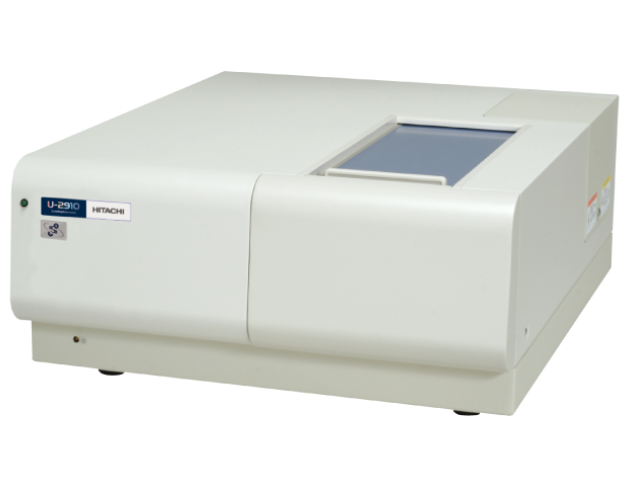
HITACHI U-3900/U-3900H 分光光譜儀
加入詢問車
產品說明
U-3900 單分光器、雙光束 UV-VIS 分光光譜儀
U-3900H 雙分光器、雙光束 UV-VIS 分光光譜儀
U-3900/3900H Spectrophotometer
日立U-3900/3900H分光光度計可滿足各種分析需求,分析物件從固定材料到液體材料。該型儀器共有兩種類型,可以根據分析檢測目的和用途的需要選擇。該型儀器應用範圍廣,重點應用於水質、環境、生物技術、製藥、材料等領域的分析檢測。
Covers a wide variety of analysis needs from liquid samples to solid samples. Line-up of two types that can be selected in accordance with the measuring object and application. For use in a wide range of fields that focus on water quality, the environment, biotechnology, pharmaceuticals, materials, etc.
Features
•Possible to perform measurements in a wide absorbance range with low stray light and low noise.
The larger the amount of transmitted light, the lower the noise of the obtained absorption spectrum so that a wider absorbance range can be measured. Measurements of high concentration samples can be performed over a wider concentration range.
•Stable spectrometer with double beam optical system
The light source uses a WI lamp (visible range) and a D2 lamp (ultraviolet range) that switches wavelength depending on the measurement. The double beam system divides the monochromatic light so that the diffraction grates into the control and the sample with a rotational mirror, guiding the light to the sample chamber. Single Monochrome Type U-3900 uses a spherical surface mirror in front of the entrance slit, while the Double Monochrome Type U-3900H uses diffraction grating.
•UV Solutions for U-3900 (PC connected) allows for easy device control and supports various quantitative-analysis functions.
Special operation software that offers substantial functions such as measurement data comparison and a preview function that allows for a more powerful analysis.
•Substantial accessories for both liquid and solid measurements
There is an abundant lineup of accessories to accommodate multiple sample and micro sample applications, etc.
Loaded with aberration-corrected concave grating
• The U-3900/3900H provides aberration-corrected concave gratings with a Seya-Namioka Mount for the spectrometer.
Both condensing and dispersing functions allow for a bright optical system, but with fewer mirrors so that light loss and aberrations are reduced.
Two types of optical systems: Single Monochrome (U-3900) and Double Monochrome (U-3900H)
• A lineup of two models with different spectrum systems: Single Monochrome (U-3900) and Double Monochrome (U-3900H).
The Single Monochrome is suitable for a low-concentration sample since sample light energy is stronger compared tothe Double Monochrome. The Double Monochrome is suitable for a high-concentration sample since it can measure high absorbance with little stray light.
U-3900H 雙分光器、雙光束 UV-VIS 分光光譜儀
U-3900/3900H Spectrophotometer
日立U-3900/3900H分光光度計可滿足各種分析需求,分析物件從固定材料到液體材料。該型儀器共有兩種類型,可以根據分析檢測目的和用途的需要選擇。該型儀器應用範圍廣,重點應用於水質、環境、生物技術、製藥、材料等領域的分析檢測。
Covers a wide variety of analysis needs from liquid samples to solid samples. Line-up of two types that can be selected in accordance with the measuring object and application. For use in a wide range of fields that focus on water quality, the environment, biotechnology, pharmaceuticals, materials, etc.
- 相差補正式光柵→光柵雙單光器、雙光束光譜儀
- 波長範圍:190~900nm(1,100nm Optional)
- 基線穩定度:0.0003Abs/hr、0.0004Abs/hr (at 340nm)
- 細微光學聚焦及液槽長度自動轉換功能適用於微量樣品之測定
- 低迷光設計針對高濃度樣品測定具有高度可靠性
- 自動校正及診斷功能確保儀器可信度
- 靈活的軟體應用及多種光學附件選用
- 光譜圖或資料可無限制的儲存在檔案中
Features
•Possible to perform measurements in a wide absorbance range with low stray light and low noise.
The larger the amount of transmitted light, the lower the noise of the obtained absorption spectrum so that a wider absorbance range can be measured. Measurements of high concentration samples can be performed over a wider concentration range.
•Stable spectrometer with double beam optical system
The light source uses a WI lamp (visible range) and a D2 lamp (ultraviolet range) that switches wavelength depending on the measurement. The double beam system divides the monochromatic light so that the diffraction grates into the control and the sample with a rotational mirror, guiding the light to the sample chamber. Single Monochrome Type U-3900 uses a spherical surface mirror in front of the entrance slit, while the Double Monochrome Type U-3900H uses diffraction grating.
•UV Solutions for U-3900 (PC connected) allows for easy device control and supports various quantitative-analysis functions.
Special operation software that offers substantial functions such as measurement data comparison and a preview function that allows for a more powerful analysis.
•Substantial accessories for both liquid and solid measurements
There is an abundant lineup of accessories to accommodate multiple sample and micro sample applications, etc.
Loaded with aberration-corrected concave grating
• The U-3900/3900H provides aberration-corrected concave gratings with a Seya-Namioka Mount for the spectrometer.
Both condensing and dispersing functions allow for a bright optical system, but with fewer mirrors so that light loss and aberrations are reduced.
Two types of optical systems: Single Monochrome (U-3900) and Double Monochrome (U-3900H)
• A lineup of two models with different spectrum systems: Single Monochrome (U-3900) and Double Monochrome (U-3900H).
The Single Monochrome is suitable for a low-concentration sample since sample light energy is stronger compared tothe Double Monochrome. The Double Monochrome is suitable for a high-concentration sample since it can measure high absorbance with little stray light.
| Item | U-3900 | U-3900H |
|---|---|---|
| Monochromator | Diffraction grating Single monochromator Seya-Namioka mount |
Diffraction grating-diffraction grating Double monochromator Seya-Namioka mount |
| Wavelength range | 190 to 900 nm | |
| Spectral bandpass | 0.1, 0.5, 1, 2, 4, 5 nm (6 steps) | |
| Wavelength accuracy | ±0.1 nm (at 656.1 nm after wavelength calibration) | |
U-3900/U-3900H 規格
| Item | U-3900 | U-3900H |
|---|---|---|
| Monochromator | Diffraction grating Single monochromator Seya-Namioka mount |
Diffraction grating-diffraction grating Double monochromator Seya-Namioka mount |
| Wavelength range | 190 to 900 nm | |
| Spectral bandpass | 0.1, 0.5, 1, 2, 4, 5 nm (6 steps) | |
| Wavelength accuracy | ±0.1 nm (at 656.1 nm after wavelength calibration) | |



